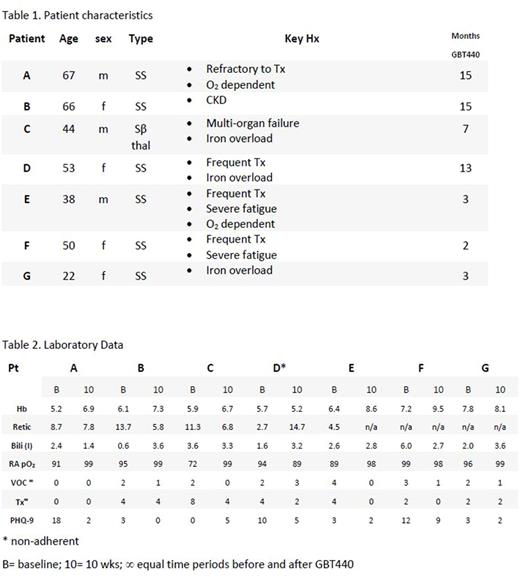Abstract

A single center experience of GBT440 treatment of severe anemia in sickle cell disease (SCD)
Authors
Gershwin Blyden, Kenneth Bridges, Josh Lehrer, Lanetta Bronté.
Academic Centers/ Institutions
Foundation for Sickle Cell Disease Research, Hollywood FL
Background
GBT440 is an oral, once-daily therapy that modulates hemoglobin's affinity for oxygen, thereby inhibiting HbS polymerization. Clinical trials assessing efficacy and safety in SCD are underway including a randomized Phase 3 study. Patients with SCD and severe anemia, i.e. Hb < 6.5 g/dL, are excluded from the trials of GBT440 but represent a major unmet need. To further describe the emerging clinical profile of GBT440, we summarize the experience of seven patients with severe anemia refractory to conventional therapy who were treated with GBT440 for up to 15 months under the GBT Expanded Access Program.
Methods
Once-daily GBT440 began at 900 mg. Initial assessments at 2 and 4 weeks were followed by routine evaluations at least monthly. Table 2 shows the key tests. Baseline echocardiograms were performed. PHQ-9 assessment at each visit gauged depression and was accompanied by a simple 1-10 pain score index. All transfusions and hospitalizations were captured.
Results
Tables 1 and 2 summarize the patient clinical characteristics and laboratory data. In 5/7 patients, baseline Hb was < 6.4 g/dL with two < 6 g/dL, including pt A who was alloimunized and refractory to transfusion. The other 6 patients received intermittent transfusions, often associated with VOC admissions. Except for pt D who was non-adherent, GBT440 increased Hb in all patients and the increase exceeded 2 g/dL in two. In 4 of the 6 tranfusable patients, transfusions fell by at least half comparing similar time periods before and after GBT440. VOC admissions fell by 60%. Daily background pain also decreased as assessed by 1-10 pain scale. In three patients with resting RA O2 sat ≤ 90% (A, C, E) values rose to 98-99% and two (A,E) ceased chronic supplemental O2. Pts A and B have received GBT440 for more than 15 months. All patients experienced striking improvement in overall well-being and reduced fatigue, most often within 2 to 3 weeks of starting GBT440. In most, mood improved and depression lessened as assessed by PHQ-9. GBT440 was well-tolerated with no dose reductions or discontinuations at 900 mg. An increase to 1500 mg in Pt A caused grade 2 diarrhea which resolved with a return to 900 mg. No GBT440-related SAE occurred. Pt C died in the setting of ACS, unrelated to GBT440.
Conclusion
In these 7 SCD patients with severe anemia who were not eligible for the Phase 3 clinical program, GBT440 administered via the EAP substantially improved a variety of clinical, laboratory and PRO parameters. Controlled clinical trials will be needed to confirm the benefit of GBT440 in patients with severe anemia.
Bridges: Global Blood Therapeutics: Employment.
Author notes
Asterisk with author names denotes non-ASH members.

This icon denotes a clinically relevant abstract


